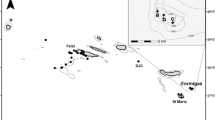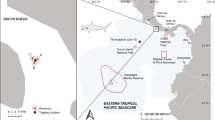Abstract
The effectiveness of marine reserves for highly mobile reef fishes such as jacks and trevallies is normally assumed to be small, even though we generally lack the understanding of their long-term movement patterns. In this work, we combined the analysis of multi-year landings and underwater visual census with acoustic telemetry to investigate the long-term movement patterns (up to 4 years) of almaco jack, Seriola rivoliana, a large reef top predator, in one protected and one unprotected offshore shallow seamount in the Azores, central North Atlantic. Although the analysis of visual census and landing data suggests a pronounced seasonal pattern of occurrence, we found that tagged fish were almost continuously detected at the seamounts for up to four consecutive years. Some individuals showed a few long periods of undetection of 1–2 months in the Formigas reserve, mostly in the fall and winter. Mobility within this seamount increased during spring and summer, and geostrophic current speed was negatively correlated with detection probability. Overall, the acoustic telemetry results showed that adult almaco jacks were resident year-round, refuting the traditional view that these fish are essentially migratory and a seasonal occurrence in the Azores. Given the intrinsic vulnerability of resident fish to fishing, our results highlight the importance of protecting these sites in order to preserve these mature fish aggregations with high reproductive potential.








Similar content being viewed by others
References
Abecassis D, Cardigos F, Alamada F, Gonçalves JMS (2009) New records on the ichthyofauna of the Gorringe seamount (Northeastern Atlantic). Mar Biol Res 5(605):611
Afonso P (2002) Spatial patterns in the littoral fish community of the Azores. MS thesis, Coimbra
Afonso P, Fontes J, Holland KN, Santos RS (2008a) Social status determines behaviour and habitat usage in a temperate parrotfish: implications for marine reserve design. Mar Ecol Prog Ser 359:215–227
Afonso P, Fontes J, Morato T, Holland KN, Santos RS (2008b) Reproduction and spawning habitat of white trevally, Pseudocaranx dentex, in the Azores, central north Atlantic. Sci Mar (Barc) 72:373–381
Afonso P, Fontes J, Holland KN, Santos RS (2009) Multi-scale patterns of habitat use in a highly mobile reef fish, the white trevally Pseudocaranx dentex, and their implications for marine reserve design. Mar Ecol Prog Ser 381:273–286. doi:10.3354/meps07946
Afonso P, Graça G, Berke G, Fontes J (2012) First observations on seamount habitat use of blackspot seabream (Pagellus bogaraveo) using acoustic telemetry. J Exp Mar Biol Ecol 1:436–437
Akaike H (1973) Information theory and an extension of the maximum likelihood principle. In: Petrov BN, Csaki F (eds) 2nd International symposium information theory, Budapest, pp 267–281
Barreiros JP, Morato T, Santos RS, de Borba AE (2003) Interannual changes in the diet of the almaco jack, Seriola rivoliana (Perciformes: Carangidae) from the Azores. Cybium 27:37–40
Bates D, Maechler M, Bolker B (2011) lme4: Linear mixed-effects models using S4 classes. R package version 0.999375-42. http://CRAN.R-project.org/package=lme4
Bolden SK (2000) Long-distance movement of a Nassau grouper (Epinephelus striatus) to a spawning aggregation in the central Bahamas. Fish Bull 98:642–645
Brown H, Benfield MC, Keenan SF, Powers SP (2010) Movement patterns and home ranges of a pelagic carangid fish, Caranx crysos, around a petroleum platform complex. Mar Ecol Prog Ser 403:205–218. doi:10.3354/meps08465
Capello M, Soria M, Cotel P, Potin G, Dagorn L, Freon P (2012) The heterogeneous spatial and temporal patterns of behavior of small pelagic fish in an array of Fish Aggregating Devices (FADs). J Exp Mar Biol Ecol 430:56–62. doi:10.1016/j.jembe.2012.06.022
Cardigos F (2006) Contribuição para a Implementação de Um plano de Gestão no Sítio de Interesse Comunitário Banco D. João de Castro. In: Dias E, Cancela ML, Fonsec L, Beja P, Dentinho T (eds) Gestão de recursos marinhos. Principia, Cascais, p 385
Carvalho N, Edwards-Jones G, Isidro E (2011) Defining scale in fisheries: small versus large-scale fishing operations in the Azores. Fish Res 109:360–369. doi:10.1016/j.fishres.2011.03.006
De Mitcheson YS, Cornish A, Domeier M, Colin PL, Russell M, Lindeman KC (2008) A global baseline for spawning aggregations of reef fishes. Conserv Biol 22:1233–1244. doi:10.1111/j.1523-1739.2008.01020.x
Dempster T (2005) Temporal variability of pelagic fish assemblages around fish aggregation devices: biological and physical influences. J Fish Biol 66:1237–1260. doi:10.1111/j.1095-8649.2005.00674.x
Dempster T, Kingsford MJ (2003) Homing of pelagic fish to fish aggregation devices (FADs): the role of sensory cues. Mar Ecol Prog Ser 258:213–222. doi:10.3354/meps258213
Diogo HMC, Pereira JG (2013) Impact evaluation of spear fishing on fish communities in an urban area of São Miguel Island (Azores Archipelago). Fish Manage Ecol 20:1–11. doi:10.1111/fme.12036
Diogo HMC, Pereira JG (2014) Assessing the potential biological implications of recreational inshore fisheries on subtidal fish communities of Azores (Northeast Atlantic) using catch and effort data. J Fish Biol 8:952–970
Fontes J, Machete M, Santos RS (2002) Projecto BARCA—Bases para a Caracterização de duas Pescarias Artesanais Costeiras dos Açores: redes de emalhar e peixe-porco: Relatório Final. Universidade dos Açores, Horta
Friedlander AM, DeMartini EE (2002) Contrasts in density, size, and biomass of reef fishes between the northwestern and the main Hawaiian Islands: the effects of fishing down apex predators. Mar Ecol Prog Ser 230:253–264
Gillanders BM, Ferrell DJ, Andrew NL (2001) Estimates of movement and life-history parameters of yellowtail kingfish (Seriola lalandi): how useful are data from a cooperative tagging programme? Mar Freshw Res 52:179–192. doi:10.1071/mf99153
Halpern BS (2003) The impact of marine reserves: do reserves work and does reserve size matter? Ecol Appl 13:S117–S137
Heithaus MR, Frid A, Wirsing AJ, WormMichael B (2008) Predicting ecological consequences of marine top predator declines. Trends Ecol Evol 23:537
Heupel MR, Simpfendorfer CA, Collins AB, Tyminski JP (2006) Residency and movement patterns of bonnethead sharks, Sphyrna tiburo, in a large Florida estuary. Environ Biol Fishes 76:47–67. doi:10.1007/s10641-006-9007-6
Holland KN, Lowe CG, Wetherbee BM (1996) Movements and dispersal patterns of blue trevally (Caranx melampygus) in a fisheries conservation zone. Fish Res 25:279–292
Hutson KS, Smith BP, Godfrey RT, Whittington ID, Chambers CB, Ernst I, Gillanders BM (2007) A tagging study on yellowtail kingfish (Seriola lalandi) and Samson fish (S-hippos) in south Australian waters. Trans R Soc S Aust 131:128–134
Jarvis ET, Lowe CG (2008) The effects of barotrauma on the catch-and release survival of southern California nearshore and shelf rockfish (Scorpaenidae, Sebastes spp.). Can J Fish Aquat Sci 65:1286–1296. doi:10.1139/F08-071
Manooch CS, Haimovici M (1983) Foods of greater amberjack, Seriola dumerili, and almaco jack, Seriola rivoliana (Pisces: Carangidae), from the South Atlantic Bight. J Elisha Mitchell Sci Soc 99:1–9
McClellan DB, Cummings NJ (1996) Preliminary analysis of tag and recapture data of the greater amberjack, Seriola dumerili, in the southeastern United States. In: Proceedings of the 49th Gulf and Caribbean Fisheries Institute, pp 25–45
Meyer CG, Holland KN (2005) Movement patterns, home range size and habitat utilization of the bluespine unicornfish, Naso unicornis (Acanthuridae) in a Hawaiian marine reserve. Environ Biol Fishes 73:201–210
Meyer CG, Holland KN, Wetherbee BM, Lowe CG (2001) Diet, resource partitioning and gear vulnerability of Hawaiian jacks captured in fishing tournaments. Fish Res 53(2):105–113
Meyer CG, Holland KN, Papastamatiou YP (2007) Seasonal and diel movements of giant trevally Caranx ignobilis at remote Hawaiian atolls: implications for the design of marine protected areas. Mar Ecol Prog Ser 333:13–25. doi:10.3354/meps333013
Morato T, Pitcher TJ (2008) Reconciling fisheries with conservation on seamounts. Reconcil Fish Conserv, Vols I and Ii 49: 1623–1634
Morato T, Cheung WWL, Pitcher TJ (2006) Vulnerability of seamount fish to fishing: fuzzy analysis of life-history attributes. J Fish Biol 68:209–221. doi:10.1111/j.1095-8649.2005.00894.x
Morato T, Pitcher TJ, Clark MR, Menezes G, Tempera F, Porteiro F, Giacomello E, Santos RS (2010) Can we protect seamounts for research? A call for conservation. Oceanography 23:190–199
R-Development-Core-Team (2012) R: a language and environment for statistical computing. R-project.org, Vienna
Russ GR (2002) Yet another review of marine reserves as reef fishery management tools. In: Sale PF (ed) Coral reef fishes: dynamics and diversity in a complex ecosystem. Accademic press, San Diego, pp 421–443
Sadovy Y, Domeier M (2005a) Are aggregation-fisheries sustainable? Reef fish fisheries as a case study. Coral Reefs 24:254–262. doi:10.1007/s00338-005-0474-6
Sadovy Y, Domeier ML (2005b) Perplexing problems of sexual patterns in the fish genus Paralabrax (Serranidae, Serraninae). J Zool 267:121–133. doi:10.1017/S0952836905007466
Sadovy Y, De Mitcheson YS, Cornish A, Domeier M, Colin PL, Russell M, Lindeman KC (2008) A global baseline for spawning aggregations of reef fishes. Conserv Biol 22:1233–1244
Sala E, Aburto-Oropeza O, Paredes G, Thompson G (2003) Spawning aggregations and reproductive behavior of reef fishes in the Gulf of California. Bull Mar Sci 72:103–121
Schmiing M, Afonso P, Tempera F, Santos R (2013) Predictive habitat modelling of reef fishes with contrasting trophic ecologies. Mar Ecol Prog Ser 478:201–216
Smith-Vaniz W (1986) Carangidae. In: Whitehead PJP, Bauchot M-L, Hureau J-C, Nielsen J, Tortonese E (eds) Fishes of the Northeast Atlantic and the Mediterranean (FNAM). UNESCO, Paris, pp 815–844
Stanley DR, Wilson CA (1997) Seasonal and spatial variation in the abundance and size distribution of fishes associated with a petroleum platform in the northern Gulf of Mexico. Can J Fish Aquat Sci 54:1166–1176. doi:10.1139/cjfas-54-5-1166
Stanley DR, Wilson CA (2003) Seasonal and spatial variation in the biomass and size frequency distribution of fish associated with oil and gas platforms in the northern Gulf of Mexico. Fisheries, Reefs, and Offshore Development, pp 123–153
Tanaka S (1984) Migration model and dynamics parameters of large-sized yellowtails in the Pacific along the Japanese coast inferred from tag recaptures after the year of release. Bull Jpn Soc Sci Fish 50:1341–1347
Wetherbee BM, Holland KN, Meyer CG, Lowe CG (2004) Use of a marine reserve in Kaneohe Bay, Hawaii by the Giant trevally, Caranx ignobilis. Fish Res 67:253–263. doi:10.1016/j.fishres.2003.11.004
Zuur AF, Ieno EN, Elphick CS (2010) A protocol for data exploration to avoid common statistical problems. Methods Ecol Evol 1:3–14. doi:10.1111/j.2041-210X.2009.00001.x
Acknowledgments
We thank T. Morato, F. Cardigos, N. Serpa, M. Santos, J. Sousa, G. Graça, M. Machete, J. Botelho, and the crews of R/V “Arquipélago” and R/V “Águas Vivas” for their help with field work; F. Tempera, R. Medeiros, and G. Graça for providing data and support in the production of bathymetric maps; and J. Santos for telemetry database management. A special thank is due to R. S. Santos for stimulating discussions and for his continued support to this research. FCT/MCTES-MEC provided individual support to J.F., M.S., and P.A. (SFRH/BD/12788/2003, SFRH/BPD/66532/2009, SFRH/BD/66117/2009, SFRH/BPD/27057/2006, and Ciência 2008/POPH/QREN/FEDER/COMPETE, FRCT, M3.1.5/F/168/2012). IMAR-DOP/UAz is UI&D #531 and Associated Laboratory LARSyS funded by FCT/MEC and Azorean DRCTC (OE, FEDER/COMPETE, Pro-Convergência). This paper is a contribution to the projects MARMACII (INTERREG/05/MAC/4.2/A4), SEAMOV (PTDC/MAR/108232/2008), and MoniZEC (DRCT/0281M2.1.2/I/018/2011), and received additional funding through the FCT/MCTES and DRCT “Reequipamento” programs. Research in this study was conducted in agreement with Azorean and Portuguese laws and legal requirements for the handling of vertebrate animals.
Author information
Authors and Affiliations
Corresponding author
Additional information
Communicated by J. Houghton.
Electronic supplementary material
Below is the link to the electronic supplementary material.
227_2014_2423_MOESM1_ESM.tif
Proportion of valid detections of tagged almaco jack (Seriola rivoliana) by season on the deep water acoustic receiver at Formigas, from August 2008 to September 2010. Numbers on top of columns represent number of different fish (tags) detected (TIFF 2996 kb)
Rights and permissions
About this article
Cite this article
Fontes, J., Schmiing, M. & Afonso, P. Permanent aggregations of a pelagic predator at shallow seamounts. Mar Biol 161, 1349–1360 (2014). https://doi.org/10.1007/s00227-014-2423-9
Received:
Accepted:
Published:
Issue Date:
DOI: https://doi.org/10.1007/s00227-014-2423-9




